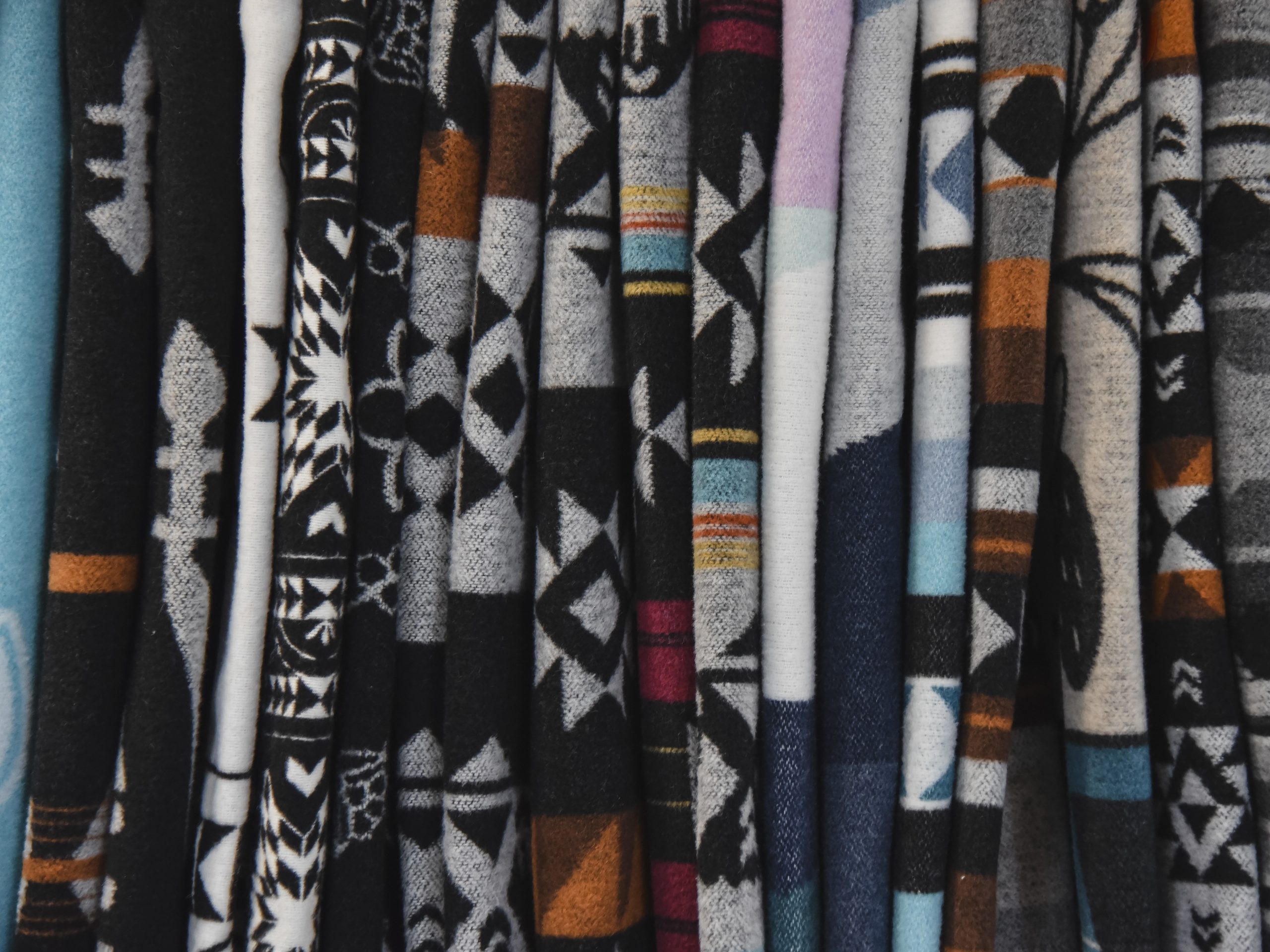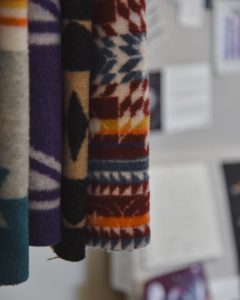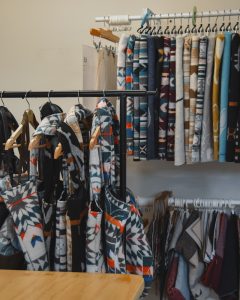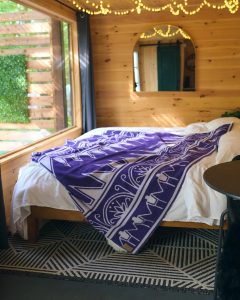
Storytelling Through Textiles: MINI TIPI’s Fall Collection
If you look at fashion houses or head to the mall, you’ll notice that winter collections are synonymous with thick wool sweaters, spring with florals, summer with bright colours and fall with earth tones, but when it comes to MINI TIPI, things are a bit different.
Here, every collection is timeless, and as such, season-less. Although autumn is a perfect time to wrap yourself up in one of their cozy blankets, you’ll soon discover that their fall collection’s trendiest aspect is its sustainability.
Follow along as the founders of MINI TIPI—Trisha Pitura, a member of Nipissing First Nation, and Melanie Bernard, from Quebec City of settler descent—invite us behind the scenes of their fall collection.

Once Upon a Time: A Conversation About Storytelling
The Fall Collection
On our visit of MINI TIPI’s warehouse a few weeks ago, we were lucky enough to spy some of the articles featured in the 2024 fall and winter collection. Lucky for you, you can now see and (even own) every piece for yourself.
While the season can play a role in their collection, Trisha explains that it’s more so about the artists they are collaborating with and sometimes even the colours they are bringing into the new pieces. “Really, it’s about inspiration. It’s about what the artist is inspired by.” And Trisha speaks from experience as she has designed many MINI TIPI motifs, including our Village blanket. She finds inspiration in Indigenous traditional art forms, whether she knows them or wishes to learn more about the teachings of other nations.
“This collection’s blankets are really unique because of Aleen Sparrow, and Tsista Kennedy,” the artists featured this fall.
Our Tour Through MINI TIPI’s Warehouse

The Generations Blanket
The inspiration behind the Generations blanket by Aleen Sparrow, from the Musqueam Nation, is the traditional art of hand weaving called Salish weaving. “It’s part of their culture to hand weave,” explains Trisha. The narrative is profound, from cultural resilience to timeless wisdom passed down through generations. Although the Salish Wool Dog that was previously sheared is now extinct, sheep’s wool allows the tradition to go on. “Salish weavers do everything by hand to create masterpieces that can be worn.”
On MINI TIPI’s website, you can read: “Generations serves as a poignant reminder of the imperative to safeguard our cultural inheritance, ensuring that the teachings, stories, and values of our ancestors endure. Like the threads that bind it, this blanket weaves together the past, present, and future, forging a timeless connection between generations and preserving the essence of who we are. Through its warmth and symbolism, it beckons us to embrace our collective responsibility to nurture and protect our cultural designs for the generations yet to come.”
Aleen began learning the traditional art form in 2019 from her mother, allowing her to reconnect with past generations and inspire the ones to come. “It was really beautiful to be able to translate a tradition that is hundreds of years old into something authentic that can be shared with so many. It’s intergenerational storytelling through textiles.”
The Unity Blanket
Trisha describes the Unity blanket premiering this autumn as “a very impactful collaboration with an incredible artist.” The artist in question, Tsista Kennedy speaks of the design on MINI TIPI’s website: “I drew inspiration from the Onyota’a: ka side of my identity inherited through my father’s lineage. I wanted this blanket to feature the Dust Fan Wampum Belt, Skydomes, and iconographic representations of people standing hand-in-hand.”
Tsista adds: “It is my hope that this blanket both educates and transcends cultures, providing a vision of a world where peace and unity are foundational to all of our communities, societies, and relations across the world, supported by a deep connection to both the natural world and the spirit world, and most importantly, sustained by the good minds of the people we share this world with.”
Keeping Traditions Alive Through Textiles
When MINI TIPI releases new collections, the patterns, the designs and all the knowledge that comes with it speak to the people from that Nation or village. “Stories have been told through arts to share teachings for generations, we just get to keep the traditions going in a more modern way,” explains Trisha. “A lot of knowledge was lost due to residential schools and colonization. Being able to share stories and traditions with a wider audience brings art to life and revitalizes the community. We just want to highlight incredible artists and give their voices a platform. We want to celebrate the culture with everyone.”
Another part of storytelling for Indigenous people has always been done orally, but that also won’t last forever, explains Trisha. “Putting it down to paper, or better yet, textiles, allows us to keep traditions alive for generations to come. Elders are survivors and many younger people are reconnecting to their culture. The youth are so resilient, and they want to learn. Even non-Indigenous people want to learn. Canada is changing.”
“People are thirsty for knowledge and the truth. We do what we do because it’s important. It’s never really been about selling a product,” Melanie pauses, “before, we used generic fabrics and the company was doing well, it was a success. But we didn’t know the artists or the stories behind them and we realized it was cultural appropriation and we didn’t want to be a part of that. So, in 2019, Trish made her first motif, and we never looked back.”
Melanie further explains their past with generic fabrics and their research for authenticity: “We realized there weren’t artists behind the generic fabrics because motifs were often stolen, and the artists weren’t compensated. We changed that; our artists have royalties. It was really important for us to implicate ourselves in our community. It’s how we measure the success of our company, by the positive impact it has on the community.”

For Seven Generations
Throughout the day, we’ve spoken of sustainability and traditions at length, but it goes deeper than that, seven generations deep to be exact. Trisha explains the principle: “When you make a decision, you do so considering the impact it will have on the seven generations to come, while respecting the seven generations that came before us. So, anytime you make a choice, you do so knowing that you’re not alone.” By revitalizing art forms, they also conserve culture for future generations. “Reconciliation won’t happen tomorrow,” says Melanie, “but it won’t happen all at once either.” Every small step is important.
Winter, spring, summer or fall, it doesn’t really matter, it’s always time for sustainability, creativity and community.

